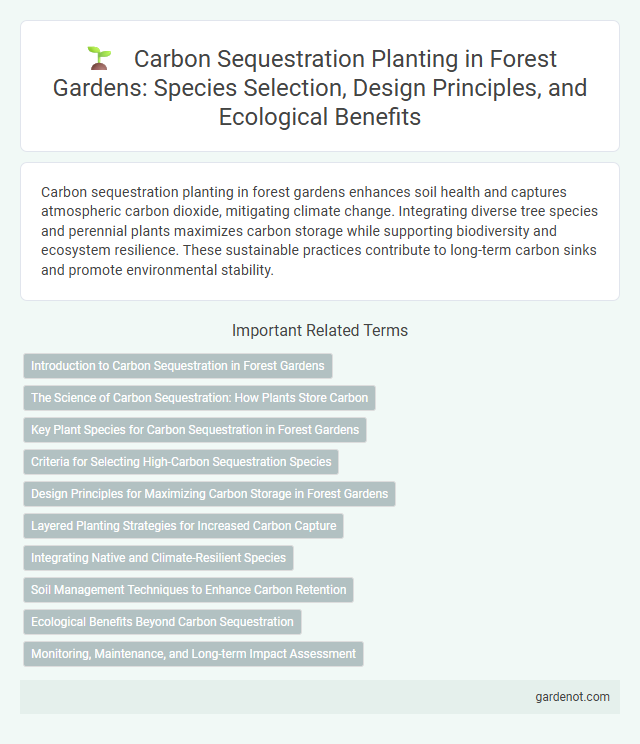Carbon sequestration planting in forest gardens enhances soil health and captures atmospheric carbon dioxide, mitigating climate change. Integrating diverse tree species and perennial plants maximizes carbon storage while supporting biodiversity and ecosystem resilience. These sustainable practices contribute to long-term carbon sinks and promote environmental stability.
Introduction to Carbon Sequestration in Forest Gardens
Carbon sequestration in forest gardens involves capturing atmospheric carbon dioxide through the growth of diverse tree species and understory plants, storing it in biomass and soil. Forest gardens enhance carbon storage by integrating perennial vegetation with multiple layers, increasing overall carbon retention compared to monoculture systems. This approach supports climate change mitigation by reducing greenhouse gas concentration while promoting biodiversity and soil health.
The Science of Carbon Sequestration: How Plants Store Carbon
Plants capture atmospheric carbon dioxide through photosynthesis, converting it into organic matter stored in biomass and soil within forest gardens. Tree roots, leaf litter, and soil microbes contribute significantly to long-term carbon storage, creating a vital carbon sink. This natural process reduces greenhouse gases and mitigates climate change by locking carbon in living and decomposing plant material.
Key Plant Species for Carbon Sequestration in Forest Gardens
Key plant species for carbon sequestration in forest gardens include nitrogen-fixing trees like black locust (Robinia pseudoacacia) and fast-growing species such as Paulownia tomentosa, which capture significant amounts of atmospheric carbon through rapid biomass accumulation. Deep-rooted perennials like chestnuts (Castanea spp.) and oak trees (Quercus spp.) enhance soil carbon storage by increasing organic matter and stabilizing carbon underground. Incorporating multilayered vegetation with understory shrubs like hazelnut (Corylus avellana) supports sustained carbon capture and biodiversity within forest garden systems.
Criteria for Selecting High-Carbon Sequestration Species
Selecting high-carbon sequestration species for a forest garden involves prioritizing fast-growing trees and shrubs with dense woody biomass and deep root systems that store significant amounts of carbon underground. Species like Douglas fir, black walnut, and certain eucalyptus varieties demonstrate high annual carbon uptake rates, making them ideal for long-term carbon storage. Additionally, native species adapted to local climate conditions ensure sustainability and resilience, enhancing overall ecosystem carbon sequestration efficiency.
Design Principles for Maximizing Carbon Storage in Forest Gardens
Design principles for maximizing carbon storage in forest gardens emphasize diverse multi-layered planting that mimics natural ecosystems to enhance biomass accumulation and soil carbon retention. Integrating nitrogen-fixing species and deep-rooted perennials promotes soil fertility and long-term carbon stabilization. Strategic spatial arrangement prioritizes high wood-density species and continuous canopy cover to optimize carbon sequestration rates over time.
Layered Planting Strategies for Increased Carbon Capture
Layered planting strategies in forest gardens enhance carbon sequestration by incorporating diverse vegetation layers such as canopy trees, understory shrubs, and ground cover plants, maximizing photosynthetic capacity and soil carbon storage. Integrating nitrogen-fixing species within these layers improves soil fertility and accelerates organic matter accumulation, further boosting carbon capture. Research shows that multilayered forest garden systems can sequester up to 30% more carbon compared to monoculture plantings due to optimized biomass production and root depth diversity.
Integrating Native and Climate-Resilient Species
Integrating native and climate-resilient species in forest garden carbon sequestration planting enhances ecosystem stability while maximizing carbon capture. Native species promote biodiversity and soil health, supporting long-term carbon storage through robust root networks and organic matter accumulation. Climate-resilient plants ensure adaptability to shifting weather patterns, safeguarding the forest garden's carbon sequestration capacity amid changing environmental conditions.
Soil Management Techniques to Enhance Carbon Retention
Soil management techniques such as no-till planting, cover cropping, and organic mulching significantly enhance carbon retention in forest gardens by improving soil structure and microbial activity. Incorporating diverse plant species with deep root systems promotes greater carbon sequestration through increased soil organic matter. Regular application of compost and biochar further stabilizes carbon in the soil, reducing greenhouse gas emissions and fostering long-term soil fertility.
Ecological Benefits Beyond Carbon Sequestration
Forest garden carbon sequestration planting enhances biodiversity by creating diverse habitats for wildlife and promoting soil health through natural nutrient cycling. This method reduces erosion and improves water retention, contributing to resilient ecosystems. Integrating native species supports pollinators and fosters a balanced ecosystem beyond just capturing carbon.
Monitoring, Maintenance, and Long-term Impact Assessment
Effective carbon sequestration in forest gardens requires systematic monitoring of tree growth, soil carbon levels, and biodiversity changes to ensure accurate data on carbon capture rates. Regular maintenance activities such as pruning, mulching, and invasive species control enhance plant health and optimize carbon storage capacity. Long-term impact assessment involves using remote sensing technologies and soil sampling to evaluate carbon stock stability and ecosystem resilience over decades.
Carbon sequestration planting Infographic

 gardenot.com
gardenot.com